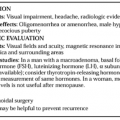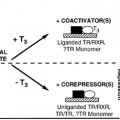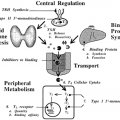TARGET GENE REGULATION BY THYROID HORMONE
The effects of thyroid hormone (TH; L-thyroxine, T4; L-triiodo-thyronine, T3) on cellular growth, development, and metabolism are legion and diverse. TH exerts its major effects at the genomic level; however, examples have been found of nongenomic action in the cytoplasm, plasma membrane, and mitochondrion.1 Early studies clearly demonstrated that TH could bind to nuclear sites and stimulate transcription and translation of new proteins.2 These early studies led to a model for genomic TH action for which the general features have been confirmed, but for which much refinement has occurred as the molecular details of TH action have been elucidated. As seen in Figure 31-1, circulating free TH enters the cell by passive diffusion, and in some tissues is converted from T4 to the more biologically potent T3 by deiodinase activity. TH then enters the nucleus and specifically binds to nuclear thyroid-hormone receptors (TRs). TRs have been shown to be intimately associated with chromatin, and ligand binding to TRs stimulates transcription of target genes and protein synthesis in a concentration- and time-dependent manner.
Stay updated, free articles. Join our Telegram channel

Full access? Get Clinical Tree






